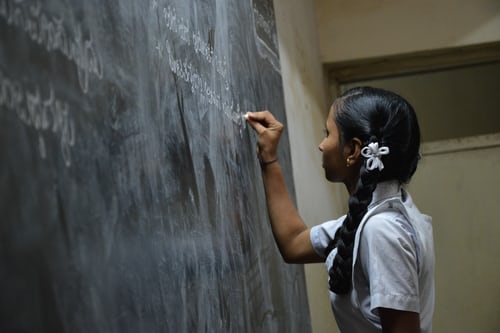Pradeep Kumar Panda
Resource constraint has been an enduring problem for the public education sector in India. The fundamental nature of basic education notwithstanding, adequate resources have been hard to come by.

A recent assessment of the gaps in the physical and human resources for fulfilling the Right to Education across the States of India, presents a disconcerting picture of gaps existing at many levels. The gap between the normative requirement and actual expenditure is particularly large in the poorer States requiring not only a higher overall fiscal push, but one that would address the unequal positions of the States. The inability of States to spend adequately on basic education has tremendous adverse consequences. The intrinsic and instrumental role of investing in public education is well documented. Furthermore, public spending on children assumes greater importance in societies and economies, such as India, that are characterised with huge structural inequalities of diverse nature and need State interventions to ensure redistribution of income, opportunities and freedoms.
Cross country global analysis shows that public investment and human development achievement go hand in hand; the current HDI values have a strong positive relation with past values on per capita public expenditure on health and education. Across Indian States, there is strong positive correlation between public investment in education and child development and empowerment. States that spend more on education score higher on the Education and Empowerment Index. From the growth perspective, researchers have noted that several Indian States could be stuck in classic low-level equilibrium trap characterised by low human development and economic growth combination, calling for policy action.
Intergovernmental transfer is an important mechanism to level the horizontal and vertical imbalances in resources across the Indian States. The federal structure of India comprises of governments at union, State and local levels. There is wide variation in economic structure and levels of development across jurisdictions leading to difference in their expenditure needs and revenue capacity. Also, as per the Constitutional directives, different levels of governments have different powers and responsibilities. While the Union government collects the major share of taxes, State governments are assigned the responsibility to make most of the expenditures on social services.
Own tax and non-tax revenues of the poorer States are relatively small. Imbalances in their abilities to raise resources have led to substantial differences in standards of social and economic services across States. Under the circumstances, the inter-governmental transfer mechanism is the only way to correct for the differences in fiscal capacities. Equalisation, in this context implies similar levels of per capita availability of the service. That is, lack of association between taxable capacity and per capita public spending on social and economic services.
The three main arms of the transfer mechanisms have been devolution of Central taxes based on recommendation of the Finance Commission (FC), various kinds of plan grants which were decided by the Planning Commission till recently, and the Finance Commission grants. As is well-recognised, devolution of divisible pool of central taxes only partially offsets the imbalances across States. It has not been able to mitigate the differences in taxable capacities. While the tax devolution has been progressive in nature, they have not been sufficiently so. For merit goods, such as elementary education (EE), there has always been a strong case for additional transfer of resources to the States.
Centrally sponsored schemes (CSS), such as the Sarva Shiksha Abhiyan (SSA), have been the main route through which the additional transfers of resources to States for financing education takes place. With the enactment of the Right to Education (RTE), the importance of SSA, which was already an existing scheme for universalisation of elementary education, increased. As the CAG’s 2017 performance audit on the implementation of the RTE observed, the Union government doesn’t make any separate financial provision for the implementation of the Act. SSA was adopted as the main vehicle for the implementation of the Act. The RTE Act also calls on the Central government to refer to the Finance Commission (FC) “the need for additional resources to be provided to any State government so that the State government may provide its share of funds for carrying out the provisions of the Act” (Section 7).

Thus, we observe that the grant mechanism has been assigned a central role in the conception of supplementary funding to the States for financing of EE. Tension between the Central Government and the State governments surrounding the CSSs In direct opposition to the above expectations, the grants for EE have dried up, especially in the recent years. While part of this is due to the overall compression in government expenditure to confirm with the FRBM targets in a scenario of weak revenue growth, there are arguments from fiscal federalism perspective which have called out the grant mechanism. Let’s look at the two major objections to central grants. In the context of Centre-State financial flows, the issue of centralizing tendencies of CSS have been raised often.
It is argued that transfer of resources by the mechanism of grants affects the freedom and maneuverability of the States in setting priorities and States should be allowed to set priorities rather than acting on Central command and control. Echoing this view, there is a combination of paternalistic, populist, and bureaucratic factors explains the proliferation of CSS in numbers and amount. Indian federal arrangement with conditional and unconditional grants is a fragmented one and strongly backs the 14th Finance Commission recommendations for a greater devolution of untied funds to the States. While this is true to an extent, the possibility of local capture is also a reality. As some have noted, earmarking and conditionality in grants have been effective in counteracting the potential for capture of local governments by local elites and in directing funds for redistribution to the neediest.
There is also no reason why the State priorities will always be correct. At times, the higher level of the government needs to set the priorities, which the lower level of government may miss. Left to its own preferences and budget, a local government might not take all national concerns into account when providing education. For example, it might set a low priority for providing special educational assistance to disadvantaged, handicapped, and bilingual children relative to national priorities. It is these disparities between local decisions and national or State concerns that become the focus of federal policy. Higher levels of government will seek to get lower levels of government to meet the overall social priorities as well as those of the lower governmental unit.

The other objection refers to the fungibility of finances, an issue that we will explore in this paper. A central idea in the theory of fiscal federalism is that all grants, earmarked or not, are essentially fungible in the sense that they may in effect be reallocated to other than the targeted spending categories – or result in tax reductions instead of spending increases of any sort. In other words, while the purpose of the specific-purpose grant from the centre may be to ensure minimum standards of services across States by adding to the State’s expenditure on services, if States reduce their own expenditure as a result of Central transfers, the system may not move in the desired direction. The mechanism of matching shares was invented so that States have a stake in the programme and contribute proportionately. The potential for grant funds to crowd out spending that the recipient government would otherwise undertake in the targeted area is generally less for open-ended matching grants, which lower the relative price of targeted spending, than for the other forms of earmarked grants – closed ended matching and categorical block grants.
That is, the design of grant matters. Furthermore, a large number of empirical studies have confirmed the existence of “fly paper effect”, which would suggest that grants do not crowd out spending that would otherwise have been undertaken by the recipient government, but result in incremental spending. The evidence also suggests that the flypaper effect, the notion that money sticks where it hits, is not an anomaly. For school education, there is a rich literature on the impact of different kinds of grants – mostly non-matching earmarked grants – across different levels of government in the US.
The effect of such grants on the total educational expenditure of a local government have either been substitutive or stimulative. A higher-level government can alter the behaviour of lower level governments by changing their preferences, relative prices of goods and income. The marginal propensity to spend State block grants for education ranges from a low of 0.16 to a high of 1.06. The individual characteristics of a local government strongly influences the fiscal response as does the design of the intergovernmental grant. Several European countries have used the intergovernmental grant mechanism for school education.

The role of the grant mechanism in the spread of mass education in Sweden as far back as the 19th Century can be referred. Government grant reform of 1871 had established matching grants as the dominant government grant formula. Despite the growth in these grants, and the fact that they provided local school districts with between 26% and 31% of their funding in 1865–1900, the government grants did not crowd out local funding. Instead, the matching grants were perceived as an incentive, influencing school district behaviour. The government grants stimulated the school districts to increase local funding at the pace corresponding to that of national government grants. These revenues were subsequently used to add additional teachers to the staff and to raise teacher salaries. The grants also seem to have influenced school districts’ choice of teachers.
The empirical literature on the impact of grants is fairly limited for the developing countries. There is a substitutive effect of categorical transfer to education in Central and Eastern China, but stimulating effect in Western China which is economically less developed and has low local public education expenditure. This suggests that poorer regions have a higher tendency of incremental spending on social sector with increase in income or expansion of fiscal capacity through grants. In the context of expenditure on health sector in India, the States substituted Centre’s transfer by cutting down its own expenditure on health during 1990s till 2015. Given the limited fiscal space, States may reduce their own expenditure and reallocate the funds to other sectors. We should examine the impact of the grant mechanism for elementary education on States’ expenditure. Is the relationship complementary or substitutionary? This question has not been explored in the context of grants for school education for India. The idea of financial concurrency in financing education and the experience of various CSS provides the historical context.
Historically, left to themselves in the post-independence years, only a handful of States such as Himachal Pradesh, Tamil Nadu and Kerala chose education sector as priority. The Directive Principles of State policy were far reaching in their vision. Very few States, however, adopted them. There were shortages of teachers and classrooms everywhere; single teacher schools were in large numbers. Similarly, mid-day meal (MDM) programme was demonstrated for over twenty years in Tamil Nadu. Yet very few of the other States chose to implement the scheme until the Supreme Court ruling came.
To set national priorities, and to work in concurrence – Centre and States – to achieve these objectives was therefore crucial. Arguing strongly for financial concurrency, V. K. R. V. Rao, then union minister for education and youth services, noted, “In respect of universal primary education which is a constitutional directive, some States can reach the goal in 10 years while others may need more than thirty to do so… Anything that the Centre can do to reduce these imbalances will be welcome in all quarters…Centre should increase its investment in education and make larger grants available, not only for the Central sector, but also for the Centrally sponsored sector. We need not only more education, but good education as well; and if this is to be provided and greater equality in educational opportunity is to be created to promote social justice and the creation of a socialistic pattern of society more funds will have to be found for education… I recommend very strongly “financial concurrency” in education…”.
With the inclusion of education in the concurrent list in 1976, Centre was expected to play a greater role in financing education. The proactive manner in which the GoI acted following the adoption of the National Policy on Education, 1986 stands out as a landmark innovation in education policy. This made the GoI the prime mover in designing and implementing development initiatives in EE. Direct involvement of the central government in strengthening infrastructure and delivery of EE allowed the States to act favourably.
Operation Black Board initiated by the central government was focused on making single teacher primary schools as two teacher schools with one of them being a lady teacher. Around the same time the scheme for restructuring and reorganization of teacher education was launched. District Primary Education Programme (DPEP) was launched in mid 1990s to universalize EE in selected districts of the country and gradually spread to 242 districts. The most important consequence of the DPEP is a relaxation of the resource constraints in planning education.

Educational planning under austerity had been the characteristic feature of planning education in India for a long time, as in many developing countries. Perhaps for the first time, the districts in India were told that each district participating in the DPEP would be given about Rs 40 crores for a seven-year period. MDM, which was already in operation in a few States, was universalised across the country with cooked meals replacing dry ration. Central financing for MDM recorded an increase over the last three plan periods.
SSA, a major CSS, was conceptualized in 2000-01 as additional finances by the GoI over and above the existing State expenditures to invest in various components of education expenditure on quality improvement and capacity building. The first decade of the millennium witnessed unprecedented levels of attention paid to education in terms of programmes in the country and investments. There was rapid spread of educational facilities in terms of new schools, and official statistics recorded near universal enrolment of children in primary schools. Children from marginalized social groups became part of the mainstream education system and there was a conscious effort towards gender parity. SSA, which worked through the system of matching grants with a declining central share through the lifecycle of the grant, accounted for more than 80% of plan expenditure.
However, as the literature suggests, SSA had several weaknesses. Along with the issue of States’ sovereignty, the one size fits all approach and a uniform matching formula for most States has continued to be a problem. Particularly, on the question of adequacy and equity in fund flows across States, SSA didn’t do enough. The quantum of SSA central grants to the States was far short of the resources necessary to meet the funding deficits for the poorer States. In fact, it was during the SSA years that the financial concurrency began to be reversed. Centre’s share in total public expenditure on EE increased from 0.6% in 1981-82 to 8.6% in 1995-96, reaching 28% in 2006-07. Beyond 2006-07 there is a reversal of the trend. The share of Centre’s expenditure in total expenditure on EE has come down to 14% in 2016-17. The 12th plan period actually saw an absolute decline in Centre’s expenditure on EE. Central allocation on SSA has stagnated or even fallen in some recent years.
In the past, Finance Commissions have recommended grants for education. The 12th FC (2005-10) recommended grants towards equalization of educational expenditures for eight States (Assam, Bihar, Jharkhand, MP, Orissa, Rajasthan, UP and WB). The grant amount of Rs 10,172 crores was to be utilized only for the sector with minimum conditionality governing the release and utilization of the grants. The 13th FC (2010-2015) recommended grant for EE specifically to the tune of Rs 24,068 crores, covering most States. The grant was to enable the States to meet the higher matching share for SSA allocations. The volume of the grant, though meager, compared to the gaps in funding that the States had. A minimum expenditure growth of 8% in States’ expenditure was required to avail the grant.
The 14th FC (2015-2020) chose not to provide any specific purpose grant for education to the States. Instead the States were expected to spend out of the greater tax devolution and the corresponding increases in revenues. It seems that this has not happened in adequate measure. Based on our own calculations for the last three years from State Budgets, we find that the overall growth in expenditure of the States on EE has been very modest. Even though the growth in nominal GDP exceeded 11%, between 2015-16 to 2017-18, the average annual growth in EE expenditure was 7.9% for all-India, and 6.3% for the poorest States combined (Bihar, UP, MP, Odisha, Rajasthan, West Bengal, Chhattisgarh and Jharkhand). Growth in per child expenditure is even more pale. The above trends – both the long run picture and the most recent trends when financial concurrency has been reversed, central grants are stagnant/falling and it looks like that States are cutting back on their expenditure – present an urgency to examine the impact of intergovernmental transfers for EE on States’ expenditure pattern. Did the growth in Central spending create conditions for growth of States’ expenditure on education or did it substitute it? Remember States provide the bulk of the spending on education and bear the primary responsibility for service delivery.
What do these results based on past trends mean for public expenditure on EE, especially for the focus states? It bears repeating that the additional requirement on EE is very large for these states. Public resources are necessary to fill the teacher gaps, bring about parity in pay around a decent salary norm, run teacher education institutions and teacher training programmes, provide for an adequate management structure, provide for maintenance of schools, learning resources and students’ entitlements, etc. Concerted effort is needed for inclusion of out of school children, among other things. The 16 focus states cannot meet these gaps by themselves due to the small revenue base compared to the disproportionately high requirements. There is an imminent need for a big push in terms of additional financing for these states. Higher transfer through additional grants is important for the focus states for narrowing the resource gaps. Addressing adequacy issues would automatically address inequalities across states. This calls for a restoration of concurrency in financing elementary education, and a reversal of the current trend.
The presence of complementarity between central grants for SSA and states spending, as indicated in this paper, needs to be tapped to provide the necessary fiscal resources for continuation of the existing programmes, expansion and improvements in the system. Central transfer through SSA has played a positive role and therefore must be continued, expanded but also strengthened to embrace the equalisation principle. A higher Central share in SSA for the GCFS, as demonstrated in the case of SCFS, should be considered for a more positive impact on States’ spending. In addition, the concerns on the question of autonomy to determine educational strategies based on local contexts needs to be addressed. Financial concurrency and need-based decentralised planning and implementation should go hand in hand. States’ priorities to education spending has a significant positive impact on the states’ expenditure. The trend indicates that states’ priorities have moved in a narrow range over the past few decades. While it is true that state priority is higher in the 16 focus States (particularly among the GCFS) than the rest, there’s been no upward movement in the variable. It shows the limited fiscal space of these states and lack of reprioritisation option, which is often suggested as a way to raise education expenditure, ignoring the actual trend.
The National Education Policy 2020 recommendations are on a similar vein when it says that the investment in education is to be increased from current 10% of overall public expenditure to 20% over a 10-year period, both for the Centre and the States. With the clear evidence of reversal in financial concurrency presented, and the stagnant trends in State priorities, the strategy approach to financing in NEP, 2020 seems unreal. For NEP, 2020 to have real teeth, the Centre should lead by example, raise allocation on education and restore financial concurrency. States revenue indeed has a strong positive impact on education expenditure and could be considered as a strategy for raising states’ expenditure on education. The elasticity comparisons show that the expansion in revenues in that case has to be considerably higher. Unfortunately, this avenue has always been limited for the poorer states. Also, if the growth in untied funds happens at the cost of CSS funding, it is a cause for concern. The SSA can have a much greater direct impact through additional specific purpose funds from the Centre and matching share by the States, along with an indirect impact through states spending on education. Since the impact of growth of untied funds is negotiated through competing demands and priority accorded to the sector by the States, it is expected to be weaker. This is broadly how the states responded in the context of the 14th FC, which ruled in favour of greater untied funds and against special purpose grant.
The positive effect of the 13th FC grant, over and above the SSA grant, on states spending should be considered by the 15th FC to propose an equalisation grant for EE. Unlike the 13th FC, however, the FC grant has to be much larger in volume. The grant has to be based on equalisation principle and extend to the 16 focus states. In other words, we are calling for a differential treatment across states. The basis for equalisation grant needs to be the additional funding that the states require, so as to be able to meet the gap in basic facilities in public schooling as per the RTE. The recent Report of the 15th Finance Commission for FY 2020-21 (GoI 2019) recommends performance-based grant for EE. These conditional grants to states are to provide financial incentives for best performing States judged in terms of improvement in certain performance parameters. This approach simply cannot work. “Such a post-hoc approach is unlikely to amount to much in a world in which most local governments depend on secure (pre-committed) grant funding to carry out many of their activities, in which many grants are intended in large part to meet “needs” rather than to reward those who have already succeeded in doing so, and in which, in any case, “good performance” invariably lies in part in the eyes of the beholder.
One would also like to draw attention to the fact that performance-based grant violates the principle of equalization governing FC transfers. Penalising the poorly performing states by depriving them of the necessary funds, would mean penalising the children. Instead a need-based equalisation grant addressing the unequal positions of these states is what is the need of the hour. This is necessary to equalise the opportunities across children, irrespective of their background.
(The author is an economist based in New Delhi. Views are personal.)






















